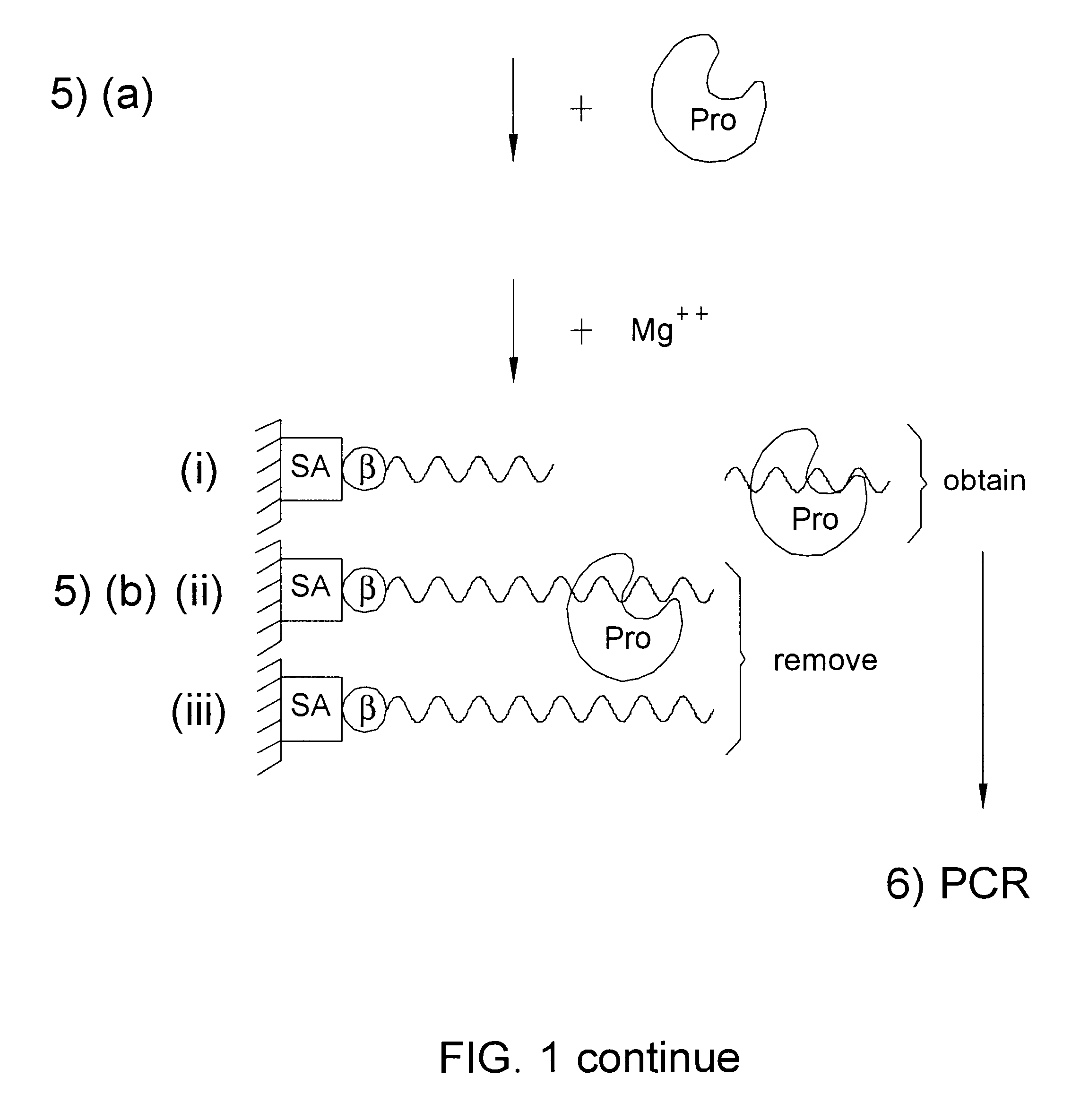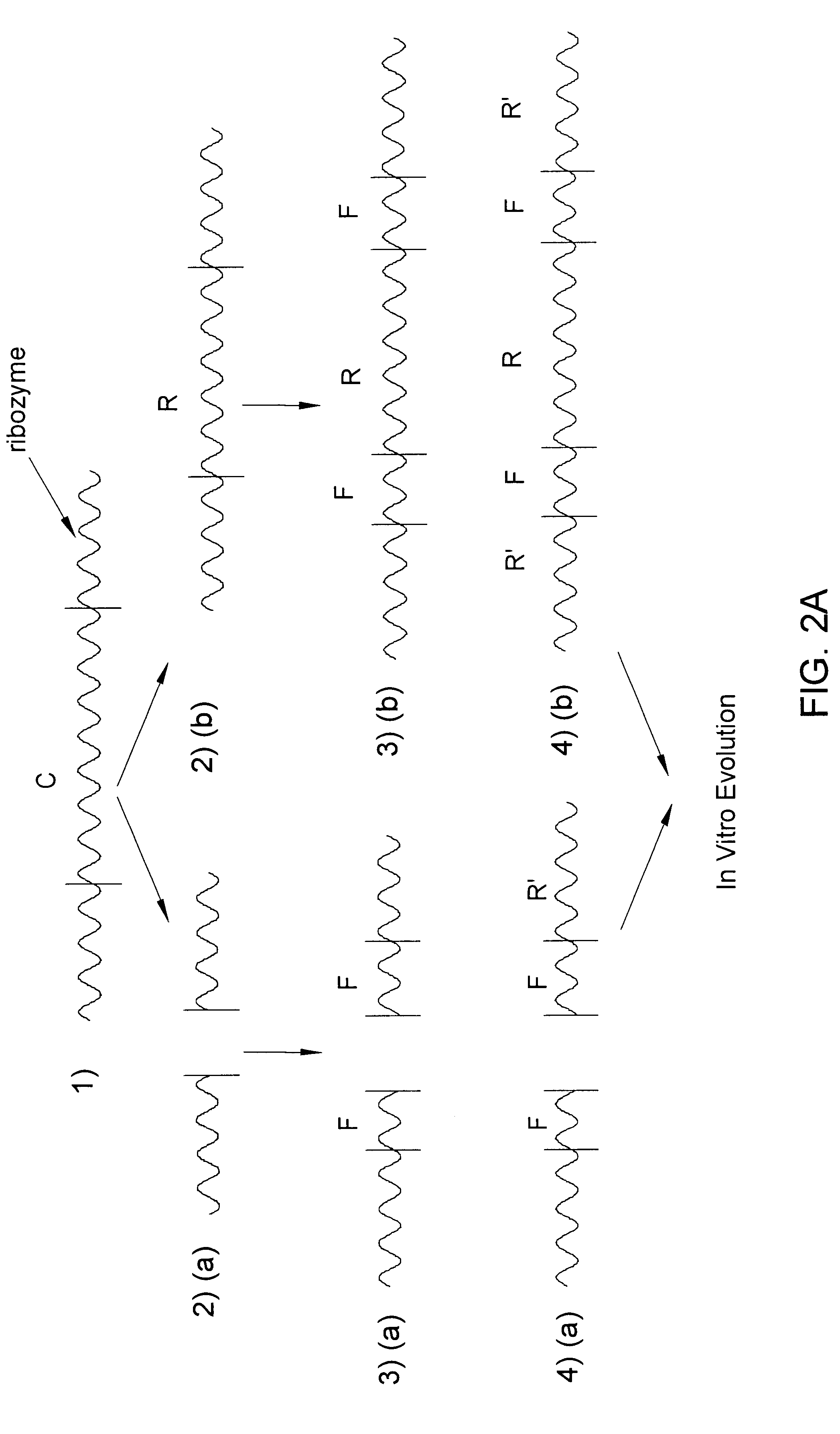Catalytic nucleic acid and methods of use
a technology nucleic acid, applied in the field of catalytic nucleic acid, can solve the problem of rendering ribozymes impractical for diagnostic purposes
- Summary
- Abstract
- Description
- Claims
- Application Information
AI Technical Summary
Benefits of technology
Problems solved by technology
Method used
Image
Examples
example 1
In Vitro Evolution Where the Co-factor is a Protein
i. Preparing Random Panel of Nucleic Acid Sequences (1)
A random panel of DNA sequences is prepared on a standard nucleic acid synthesizer using a program for generating random sequences.
A typical sequence is shown in FIG. 1 step (1) and comprises a promoter (P) of about 20 b.p., a sequence which is cleavable in cis by a catalytically active ribozyme termed in the figure "substrate" (S) of about 10 b.p. (both these sequences are constant and not random), a random generated sequence (R) of 50-8000 b.p. averaging at 100, and two sequences, one upstream of the random sequence and one downstream thereof, which serve as primer for PCR (M).
ii. Preparation of immobilized nucleic acid sequences (2 and 3)
The DNA sequences of i. above, are transcribed, using a primer with biotin (B) at the 5' end (FIG. 1, step 2). The biotin, is then allowed to react with avidin which is present on a solid support, such as Stepravidin beads (SA), so that each ...
example 2
Preparing Co-factor Binding Haptens
As a preliminary step before constructing the DNA sequence of step 1 (in FIG. 1), it is possible to find first short sequences (haptens) which are capable of binding the desired co-factor (protein).
The procedure for the preparation of such haptens is as follows:
1. Short random sequences (about 80 base pairs) are prepared, and allowed to react with the protein co-factor.
2. Those sequences which bind the protein co-factor are identified for example, by the use of antibodies against the protein, by absorption of a protein to a membrane capable of absorbing proteins, etc. and are separated from the other sequences which did not bind to the protein.
3. Sequences which were obtained in step 2 are amplified.
4. Steps 2 and 3 above are repeated for 10-30 cycles so that the reaction mixture is enriched with haptens capable of binding the specific protein co-factor.
These short haptens then serve as part of the random sequence (R) shown in step 1 of FIG. 1.
example 3
Preparation of a Semi-random Nucleic Acid Sequences
Sometimes, for in vitro evolution purposes, it is desired that the newly prepared panel of sequences resemble to some degree a known sequence, for example that of a ribozyme. If for example, it is desired that the semi-random sequence has a 70% average similarly to a specific nucleic acid sequence, it is possible to provide the nucleic acid synthesizer instead of four pure solutions containing each of the nucleotides (A, T, G and C), with four bottles each containing a solution composed of 70% one nucleotide (for example A), and 10% of each of the other three nucleotides (10% G, 10% T and 10% C). By instructing the synthesizer to construct a sequence utilizing these four mixtures, it is possible to obtain a sequence which has a 70% similarity to a known sequence. Other percentages of similarity may of course be used.
PUM
| Property | Measurement | Unit |
|---|---|---|
| Fraction | aaaaa | aaaaa |
| Composition | aaaaa | aaaaa |
| Catalytic activity | aaaaa | aaaaa |
Abstract
Description
Claims
Application Information
 Login to View More
Login to View More - R&D
- Intellectual Property
- Life Sciences
- Materials
- Tech Scout
- Unparalleled Data Quality
- Higher Quality Content
- 60% Fewer Hallucinations
Browse by: Latest US Patents, China's latest patents, Technical Efficacy Thesaurus, Application Domain, Technology Topic, Popular Technical Reports.
© 2025 PatSnap. All rights reserved.Legal|Privacy policy|Modern Slavery Act Transparency Statement|Sitemap|About US| Contact US: help@patsnap.com



